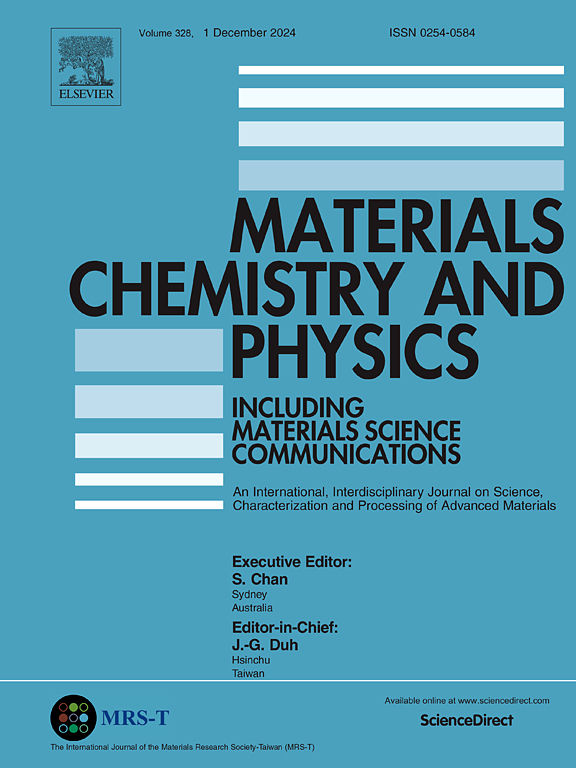Probiotic bacteria Bacillus licheniformis mediated sustainable green synthesis of nanoparticles and its multifaceted mechanisms to control dermal pathogens
IF 4.7
3区 材料科学
Q2 MATERIALS SCIENCE, MULTIDISCIPLINARY
引用次数: 0
Abstract
Nanotechnology is advancing at a remarkable pace, has gained significant attention for its applications in healthcare, especially through the development of nanoparticles with unique physicochemical properties. Among various metal nanoparticles, silver nanoparticles (AgNPs) have emerged as potent agents due to their broad-spectrum antimicrobial, anti-inflammatory, and wound-healing properties. The research emphasizes a sustainable approach to synthesize nanoparticles by using probiotic bacteria Bacillus licheniformis (BlNps) and to evaluate their potential in dermatophytic fungal pathogens, especially for acne treatment. The synthesis of BlNps was confirmed using UV–Visible spectroscopy, with peak observed at 430 nm. Additional characterizations were performed using Dynamic Light Scattering (DLS), Zeta Potential analysis, Fourier Transform Infrared (FTIR) spectroscopy, Field Emission Scanning Electron Microscopy (FESEM), and X-ray Diffraction (XRD). Dynamic light scattering (DLS) analysis showed an average particle size of 255.0 nm with the zeta potential value of −20.8 mV. XRD analysis confirmed FCC crystalline framework of BlNps. FESEM results confirmed the predominant presence of spherical shaped nanoparticles with small proportion of polymorphs with the size ranging between 30 and 50 nm confirming the synthesis of nanosized particles. EDAX analysis confirms the presence of silver. Toxicity assessment was performed in zebrafish to determine the biocompatibility and safety of the nanoparticles and confirms a dose-dependent toxic effect in zebrafish embryos. Antifungal efficacy of BlNps was examined by treating two dermatophytic fungi, namely Microsporum canis and Trichophyton rubrum strains with the synthesized nanoparticles. Results revealed a significant reduction in fungal growth, with inhibition rates of 68 % and 69 % for strain 1 and strain 2 at concentration of 250 μg/ml, respectively. Antibacterial efficacy was examined in Staphylococcus aureus strains and results revealed a strong growth inhibition at 25 μg/ml and 12.5 μg/ml of BlNps. These findings suggest that probiotic bacteria mediated BlNps hold promising potential for safe and effective dermal applications, particularly for the control of skin infections caused by microbes.

益生菌地衣芽孢杆菌介导的纳米颗粒可持续绿色合成及其控制皮肤病原体的多方面机制
纳米技术正在以惊人的速度发展,特别是通过开发具有独特物理化学性质的纳米颗粒,在医疗保健领域的应用获得了极大的关注。在各种金属纳米颗粒中,银纳米颗粒(AgNPs)由于其广谱抗菌、抗炎和伤口愈合的特性而成为一种有效的药物。该研究强调利用益生菌地衣芽孢杆菌(BlNps)合成纳米颗粒的可持续方法,并评估其在皮肤真菌病原体,特别是痤疮治疗中的潜力。用紫外可见光谱法对合成产物进行了验证,在430 nm处观察到峰。使用动态光散射(DLS), Zeta电位分析,傅里叶变换红外(FTIR)光谱,场发射扫描电子显微镜(FESEM)和x射线衍射(XRD)进行了额外的表征。动态光散射(DLS)分析表明,该材料的平均粒径为255.0 nm, zeta电位值为- 20.8 mV。XRD分析证实了BlNps的FCC晶体结构。FESEM结果证实,纳米颗粒以球形为主,多晶体比例较小,尺寸在30 ~ 50 nm之间,证实了纳米颗粒的合成。EDAX分析证实了银的存在。在斑马鱼中进行了毒性评估,以确定纳米颗粒的生物相容性和安全性,并证实了斑马鱼胚胎的剂量依赖性毒性作用。利用合成的纳米颗粒对犬小孢子菌和红毛癣菌两种皮肤真菌的抑菌效果进行了研究。结果表明,菌株1和菌株2在浓度为250 μg/ml时对真菌生长的抑制率分别为68%和69%。结果表明,BlNps在25 μg/ml和12.5 μg/ml浓度下对金黄色葡萄球菌生长有较强的抑制作用。这些发现表明,益生菌介导的BlNps具有安全有效的皮肤应用前景,特别是在控制微生物引起的皮肤感染方面。
本文章由计算机程序翻译,如有差异,请以英文原文为准。
求助全文
约1分钟内获得全文
求助全文
来源期刊

Materials Chemistry and Physics
工程技术-材料科学:综合
CiteScore
8.70
自引率
4.30%
发文量
1515
审稿时长
69 days
期刊介绍:
Materials Chemistry and Physics is devoted to short communications, full-length research papers and feature articles on interrelationships among structure, properties, processing and performance of materials. The Editors welcome manuscripts on thin films, surface and interface science, materials degradation and reliability, metallurgy, semiconductors and optoelectronic materials, fine ceramics, magnetics, superconductors, specialty polymers, nano-materials and composite materials.
 求助内容:
求助内容: 应助结果提醒方式:
应助结果提醒方式:


